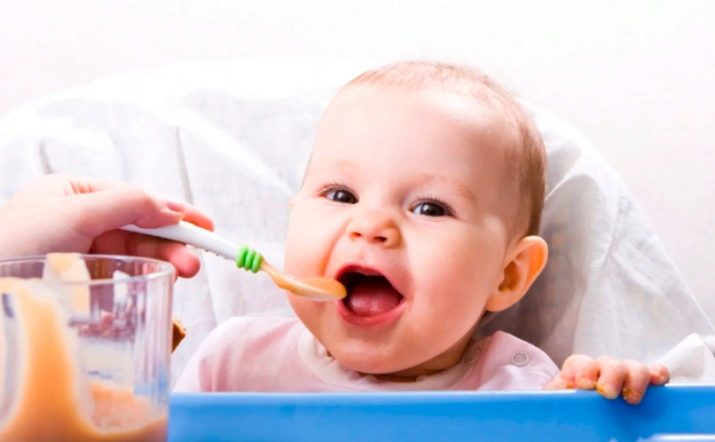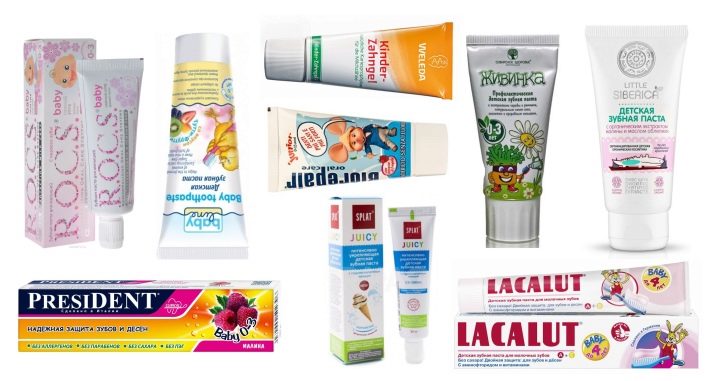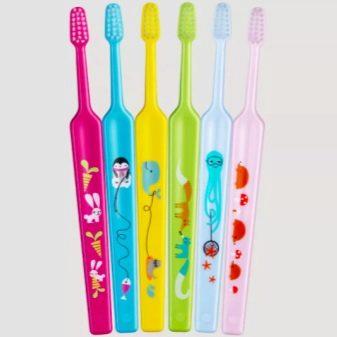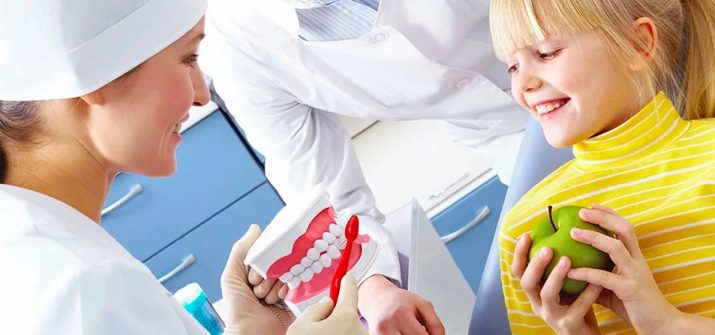All about oral hygiene for children

There is a misconception that baby teeth do not need professional care. But research has shown that not taking proper care of your oral cavity will affect the health of your permanent teeth and soft tissues. Therefore, it is important to get acquainted with the hygiene standards that should be instilled in a child from childhood.
Care features
The algorithm for caring for children's teeth includes several principles.
- Every kid needs individual care program taking into account the characteristics of his body.
- Up to four years all hygiene procedures are carried out strictly by adults because of the risk of damaging the gums. At preschool age, children can brush their teeth with the help of an adult. Independent performance of the procedure is permissible from the age of seven.
- Cleaning of the oral cavity is carried out in order to remove food contamination, which cause bacteria and fungus to multiply. Therefore, it is important to pay attention to areas that are at high risk.
- Caring for children's teeth involves developing healthy habits. To do this, first, the procedures must be carried out in an easy playful manner in order to exclude the development of fear of regular care, as well as visiting a dental office.
When choosing dental care products, you need to focus on your age. The requirements for oral hygiene under one year old differ from the procedures required for schoolchildren and adolescents.

How to care for the gums of a newborn?
Although babies do not have teeth yet, his oral cavity needs to be cared for. Lack of proper hygiene will lead to the accumulation of food debris after drinking milk or regurgitation on the gums, inner cheeks, and tongue. This creates a favorable environment for the development of fungi of the genus Candida. Outwardly, this manifests itself through a white bloom, which will cause discomfort in the baby, and is also capable of provoking intestinal disturbances. In addition, with improper hygiene, milk teeth will begin to become covered with plaque and blackness.
That's why, although babies do not clean their mouths every day, they need to be checked daily... Some mothers continue to use the little finger wrapped in gauze for the procedure. Others use fingertips and napkins that are sold at drugstores.
The main thing is that the selected napkins and other accessories consist of plant components and are safe for the baby.

When cleaning your mouth, it is important to pay attention to:
- the back of the gum;
- chewing surface, where teeth will grow in the future;
- language;
- the back of the cheeks.
When signs of thrush appear, oral hygiene is performed three times a day. For procedures, you can use a soda solution at a concentration of a teaspoon per 250 ml of water or a professional composition recommended by a doctor.
For added protection it is important to prevent bad habits in the newborn, including biting the tongue, as well as sucking fingers or foreign objects. Nutrition plays an important role.
Thus, reducing the proportion of sweet mixtures in the diet reduces the aggressive effect on the gums and future teeth.

Hygiene rules for milk teeth
Although these teeth are considered temporary, their care should not be neglected. Like permanent ones, they can suffer from tooth decay, periodontitis, pulpitis or flux. In a neglected state, these pathologies:
- destroy enamel, gums and jaw bones;
- the rudiment of a permanent tooth is affected, because of which it may appear with deviations or not grow at all;
- provoke speech and occlusion disorders;
- make it difficult to chew food, which can lead to ulcers, gastritis and constipation.

You should start caring for your teeth without waiting for everyone to grow up. The surface of already erupted teeth needs regular cleaning. In addition to protecting against caries, there is an addiction to manipulation in the oral cavity.
In the early years, it is advisable to use toys or other devices that distract the baby from the incomprehensible actions of adults. Then the procedures should become more meaningful. The child learns to keep his mouth open, which is necessary when visiting the dentist.

Evening teeth brushing is practiced for up to two years... To keep the oral cavity clean, parents are advised to abandon nighttime feedings by this time. And after the procedure, exclude juices, compotes, teas and dairy products. This is necessary to protect against acid that destroys the enamel. The nighttime diet, if the child continues to wake up, is now limited to clean water.
For preschoolers, brushing your teeth twice a day should gradually become the norm: in the morning and in the evening. The duration of the manipulation is 3 minutes. To do this, they should be provided with their own set of toothpaste and brush.
If the teeth are already tight, a thread is introduced into use. Additional funds are purchased if necessary.

It is important for schoolchildren to learn how to clean their teeth efficiently on their own. If the skill is not fully developed, you can use the game with coloring agents. After the procedure, the child is asked to chew the pill. The pigment will remain only on the plaque and will clearly show which areas remain unaffected by the brush. This is followed by repeated cleaning with the study of the correct movements.
From the age of seven, it is allowed to use toothpaste for adults, but in small quantities. You can buy a brush with a standard hardness by the age of 12, when the formation of teeth ends.

Choosing a brush and paste for children
The variety of baby pastes can be confusing for parents. However, you can choose the right tool, guided by certain parameters.
- In preschool age, the skills of spitting and rinsing the mouth are not fully developed... Therefore, we need natural compounds that are safe for the stomach.
- Up to four years in the priority of pasta free of dyes, fluoride and fragrances, so that the baby does not confuse them with food.
- Although fluoride is an essential component for teeth, excess fluoride breaks down enamel structurally.... Therefore, in a period of 4–8 years, its content should not exceed 500 ppm.
- Abrasive substances effectively remove plaque... However, calcium carbonate and sodium bicarbonate are considered too corrosive for children's enamel. They are replaced with silicic acid or titanium dioxide. The aggressiveness of abrasives is determined by the RDA scale. Up to 4 years, the indicator is 20 cu. That is, after that you can increase the value to 50 cu. e.
- Foaming agent sodium lauryl sulfate can dry out the mucous membrane and provoke allergies. Therefore, it is considered toxic to children. When choosing a paste, it is important to make sure that this component is missing.
- Antibacterial pastes containing chlorhexidine, triclosan or metronidazole are used only if there is a medical indication (stomatitis or gingivitis).

When choosing a paste, it is important to pay attention to the expiration date. If the composition retains its properties for a long time, this indicates a high amount of preservatives, which is unacceptable for a children's product.
Special attention is paid to flavoring additives... It is worth giving preference to formulations with the addition of natural ingredients, including mint, vanilla or eucalyptus. But dentists recommend giving up synthetic sweeteners.

The choice of brush is determined by the dimensions of the head and handle in accordance with the table:
|
Age |
Head size (cm) |
Handle length (cm) |
|
1–2 |
<1.5 |
<10 |
|
2–5 |
<2 |
<15 |
|
5–7 |
<2-2.5 |
<17 |
For children, attachments with soft or ultra-soft bristles are suitable. The handle with silicone or rubber insert will prevent slipping. A bright design with a favorite character will increase interest in the procedure.


Use of additional funds
Comprehensive oral care is not limited to brush and paste. Here is a list of additional products that will be required for children, adolescents and older.
Dental floss
The device allows you to get rid of food debris stuck between your teeth. It is permissible to use it from 4 years old, but under the supervision of parents. Self-application of the thread is possible from an age when the risk of damaging the gums decreases.

Rinse aid
These formulations are used to disinfect the oral cavity, eliminate unpleasant odors or relieve inflammation. They are necessary after a meal if there is no way to brush your teeth. They are bought at the age when the child has learned to spit.

Foams
These tools are also capable of replacing a toothbrush in an emergency. But it is advisable to choose them under the guidance of a dentist.

Recommendations
To keep your teeth strong and healthy, the following tips should not be neglected:
- you need to plan a visit to the dentist several times a year;
- keep the amount of sweets eaten under control;
- form the habit of rinsing your mouth after each meal;
- give more fruits and vegetables to form a chewing habit;
- add fluoride to the water to form strong enamel, take tablets with fluoride as directed by a doctor.









